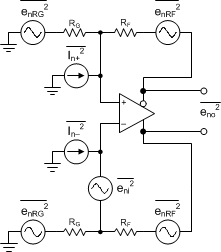ZHCSH86B December 2017 – February 2019 LMH5401-SP
PRODUCTION DATA.
- 1 特性
- 2 应用
- 3 说明
- 4 修订历史记录
- 5 说明 (续)
- 6 Pin Configuration and Functions
- 7 Specifications
-
8 Parameter Measurement Information
- 8.1 Output Reference Nodes and Gain Nomenclature
- 8.2 ATE Testing and DC Measurements
- 8.3 Frequency Response
- 8.4 S-Parameters
- 8.5 Frequency Response with Capacitive Load
- 8.6 Distortion
- 8.7 Noise Figure
- 8.8 Pulse Response, Slew Rate, and Overdrive Recovery
- 8.9 Power Down
- 8.10 VCM Frequency Response
- 8.11 Test Schematics
- 9 Detailed Description
-
10Application and Implementation
- 10.1 Application Information
- 10.2
Typical Application
- 10.2.1 Design Requirements
- 10.2.2 Detailed Design Procedure
- 10.2.3 Application Curves
- 10.3 Do's and Don'ts
- 11Power Supply Recommendations
- 12Layout
- 13器件和文档支持
- 14机械、封装和可订购信息
10.1.3 Noise Analysis
The first step in the output noise analysis is to reduce the application circuit to its simplest form with equal feedback and gain setting elements to ground (as shown in Figure 63) with the FDA and resistor noise terms to be considered.
 Figure 63. FDA Noise-Analysis Circuit
Figure 63. FDA Noise-Analysis Circuit The noise powers are shown in Figure 63 for each term. When the RF and RG terms are matched on each side, the total differential output noise is the root sum of squares (RSS) of these separate terms. Using NG (noise gain) ≡ 1 + RF / RG, the total output noise is given by Equation 8. Each resistor noise term is a 4-kTR power.

The first term is simply the differential input spot noise times the noise gain. The second term is the input current noise terms times the feedback resistor (and because there are two terms, the power is two times one of the terms). The last term is the output noise resulting from both the RF and RG resistors, again times two, for the output noise power of each side added together. Using the exact values for a 50-Ω, matched, single-ended to differential gain, sweep with 2 Ω (plus an internal 25 Ω) and the intrinsic noise eni = 1.25 nV and in = 3.5 pA for the LMH5401-SP, which gives an output spot noise from Equation 8. Then, dividing by the signal gain set through internal resistors (AV), gives the input-referred, spot-noise voltage (ei) of 1.35 nV/√Hz. Note that for the LMH5401-SP the current noise is an insignificant noise contributor because of the low value of RF.